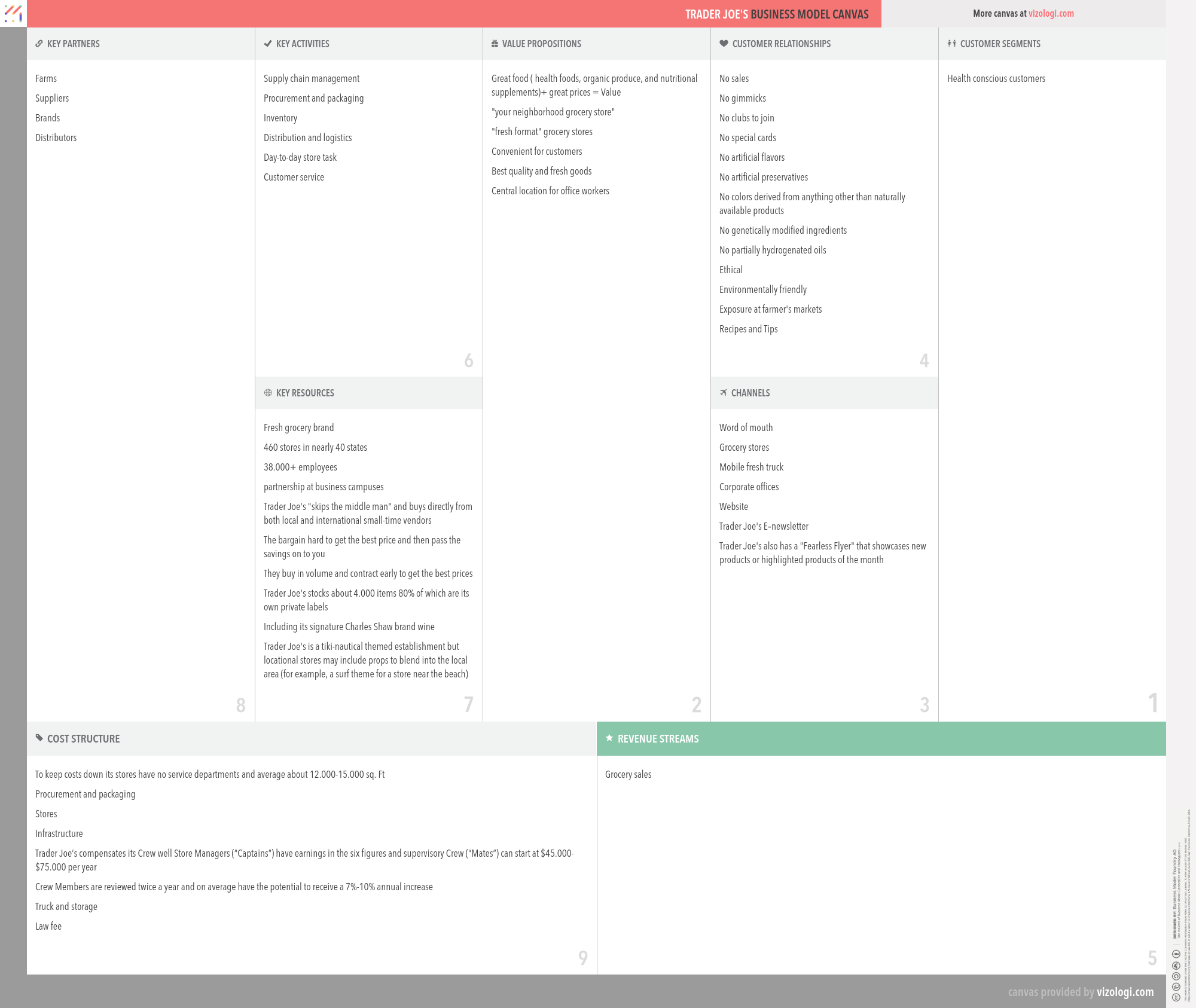Why Trader Joe's's Business Model is so successful?
Get all the answers 
Trader Joe's’s Company Overview
Trader Joe's is a privately held American chain of specialty grocery stores based in Monrovia, California, in Greater Los Angeles.
www.traderjoes.comCountry: California
Foundations date: 1958
Type: Private
Sector: Consumer Goods
Categories: Retail
Trader Joe's’s Customer Needs
Social impact:
Life changing: affiliation/belonging
Emotional: attractiveness, badge value, wellness, therapeutic value
Functional: organizes, quality, variety, sensory appeal
Trader Joe's’s Related Competitors
Trader Joe's’s Business Operations
Cross-selling:
Cross-selling is a business strategy in which additional services or goods are offered to the primary offering to attract new consumers and retain existing ones. Numerous businesses are increasingly diversifying their product lines with items that have little resemblance to their primary offerings. Walmart is one such example; they used to offer everything but food. They want their stores to function as one-stop shops. Thus, companies mitigate their reliance on particular items and increase overall sustainability by providing other goods and services.
Culture is brand:
It requires workers to live brand values to solve issues, make internal choices, and provide a branded consumer. Developing a distinctive and enduring cultural brand is the advertising industry's holy grail. Utilizing the hazy combination of time, attitude, and emotion to identify and replicate an ideology is near to marketing magic.
Direct selling:
Direct selling refers to a situation in which a company's goods are immediately accessible from the manufacturer or service provider rather than via intermediate channels. The business avoids the retail margin and any extra expenses connected with the intermediaries in this manner. These savings may be passed on to the client, establishing a consistent sales experience. Furthermore, such intimate touch may help to strengthen client connections. Finally, direct selling benefits consumers by providing convenience and service, such as personal demonstrations and explanations of goods, home delivery, and substantial satisfaction guarantees.
Ingredient branding:
Ingredient branding is a kind of marketing in which a component or ingredient of a product or service is elevated to prominence and given its own identity. It is the process of developing a brand for an element or component of a product in order to communicate the ingredient's superior quality or performance. For example, everybody is aware of the now-famous Intel Inside and its subsequent success.
Low cost:
A pricing strategy in which a business provides a low price in order to drive demand and increase market share. Additionally referred to as a low-price approach. The low-cost model has sparked a revolution in the airline industry. The end-user benefits from low-cost tickets as a result of a revenue strategy that seeks various sources of income. Ryanair was one of the first businesses to embrace this approach.
No frills:
A no frills service or product has been stripped of non-essential elements to keep the price low. Initially, the word frills referred to a kind of cloth embellishment. Something provided free of charge to clients may be a frill - for example, complimentary beverages on airline flights or a radio fitted in a rental vehicle. No-frills companies rely on the premise that by eliminating opulent extras, consumers may benefit from reduced costs. Budget airlines, supermarkets, holidays, and pre-owned cars are examples of everyday goods and services with no-frills branding.
Regular replacement:
It includes items that must be replaced on a regular basis; the user cannot reuse them. Consumables are products utilized by people and companies and must be returned regularly due to wear and tear or depletion. Additionally, they may be described as components of a final product consumed or irreversibly changed throughout the production process, including semiconductor wafers and basic chemicals.
Reseller:
Resellers are businesses or individuals (merchants) that acquire products or services to resell them instead of consuming or utilizing them. This is often done for financial gain (but could be resold at a loss). Resellers are well-known for doing business on the internet through websites. One instance is the telecommunications sector, in which corporations purchase surplus transmission capacity or take the call from other providers and resell it to regional carriers.
Self-service:
A retail business model in which consumers self-serve the goods they want to buy. Self-service business concepts include self-service food buffets, self-service petrol stations, and self-service markets. Self-service is available through phone, online, and email to automate customer support interactions. Self-service Software and self-service applications (for example, online banking apps, shopping portals, and self-service check-in at airports) are becoming more prevalent.
Supermarket:
A supermarket is a self-service store arranged into aisles and has many foods and home goods. It is bigger and has a greater variety than traditional grocery shops but is smaller and offers a more limited selection than a hypermarket or big-box market. Supermarkets are usually chain shops supplied by their parent firms' distribution centers, allowing for more significant economies of scale. In addition, supermarkets often provide items at competitive rates by using their purchasing power to negotiate lower pricing from producers than smaller shops can.
Sustainability-focused:
Companies that manufacture fast-moving consumer goods and services and are committed to sustainability do ecological impact assessments on their products and services. While research-based green marketing needs facts, green storytelling requires imagination and location. Employees responsible for the brand definition and green marketers collaborate with product and service designers, environmental groups, and government agencies.
White label:
The term white label refers to a product or service bought by a reseller who rebrands it to show that the new owner developed it. Frequently, white-label goods are mass manufactured. Thus, white-label goods are produced by one firm and sold by another under their brand and model number. For instance, most Dell computer screens are created by third-party manufacturers yet have the Dell brand and model number.
Recommended companies based on your search:

